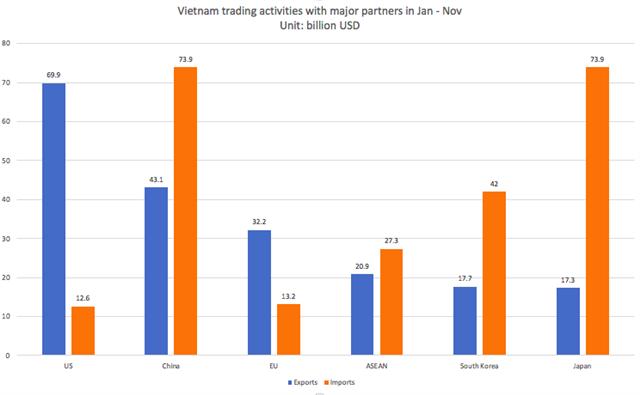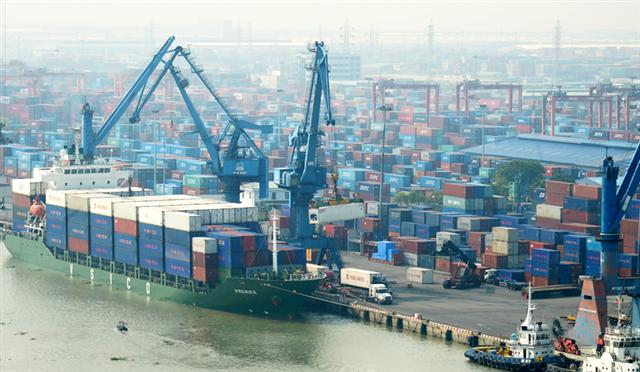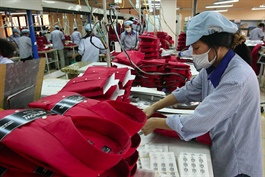2020 marks a successful year for Vietnam exports
2020 marks a successful year for Vietnam exports
The US$300-billion export target set in early 2020 remains challenging, requiring not only strong efforts from local enterprises, but also the recovery of global demand amid complicated Covid-19 situation.
Amid severe impacts of the Covid-19 pandemic, Vietnam’s exports remain a spotlight of the economy with an expansion of 5.3% year-on-year to US$254 billion, which resulted in a record high trade surplus of over US$20 billion.
By the end of June, Vietnam’s export turnover was estimated at US$121 billion, three months later, the figure rose to US$203 billion and US$254 billion as of late November. This showed Vietnam’s good adaptability to negative impacts from the Covid-19 pandemic.
In the January–November period, the US remained Vietnam's biggest export market, spending US$69.9 billion on Vietnamese goods, up 25.7% year-on-year, followed by China (US$43.1 billion, up 16%), and the EU (US$32.2 billion, down 2.4%).
General Director of the General Statistics Office (GSO) Nguyen Thi Huong said Vietnam’s high trade surplus is thanks to a positive economic growth and strong resilience of the business community.
“Enterprises in Vietnam have efficiently taken advantages of Vietnam’s free trade agreements (FTAs),” she noted.

Data: GSO. Chart: Ngoc Thuy.
|
During the 11-month period, Vietnam had 31 export items earning more than US$1 billion each, accounting for 92% of total exports, and six with over US$10 billion, or 64.3%. Among Vietnam’s key export staples, phones and parts are predicted to gross the largest export turnover during the January-November period with US$46.9 billion, down 3.4% year-on-year and accounting for 18.4% of Vietnam’s total exports.
Wood and wooden products have fetched an estimated US$10.9 billion, up 14.1% year-on-year, mainly thanks to positive impacts from FTAs.
General Secretary of the Handicraft and Wood Industry Association of Ho Chi Minh City Nguyen Chanh Phuong said wood exports to the EU have become more favorable thanks to the EU-Vietnam Free Trade Agreement (EVFTA), which became effective since August.
“The room for further export growth remains large, as the EU imports wooden products worth nearly US$80 billion per year,” stated Mr. Phuong.
Expert Le Huy Khoi from the Vietnam Institute of Industrial and Trade Policy and Strategy (VIOIT) said the country’s positive trade performance is thanks to enterprises’ effective investment in production and grasping opportunities for exports.
Moreover, the quality of domestic products has also been significantly improved that directly contributes to reducing imports of goods, he added.

Cargos handling at Dinh Vu port, Hai Phong city. Photo: Pham Hung.
|
Creating momentum for 2021
In December, a number of major export products with high demand such as electronics, computers and parts; wood and wooden products; rice; seafood, among others, would continue to bring in more revenue as Christmas and New year holidays are approaching.
The textile industry, one of the hardest-hit economic sectors by the Covid-19, is set to reach an export turnover of US$33.5-34 billion in 2020, higher than the previous forecast of US$30 – 31 billion in April.
Seafood exports are set to continue a two-digit growth rate since September. As of November, major seafood market for Vietnam such as the US, EU, China have all witnessed a surge in growth of 25%, 30% and 15%, respectively.
By year-end, Vietnam seafood exports could reach a turnover of US$8.58 billion, around the same figure of 2019.
The Ministry of Industry and Trade (MoIT), however, acknowledged that the US$300-billion export target set in early 2020 remains challenging, requiring not only strong efforts from local enterprises, but also the recovery of global demand amid complicated Covid-19 situation.
Deputy Director of MoIT’s Import and Export Department Tran Thanh Hai said the ministry would continue supporting enterprises with updated information on the global market for a more efficient operation.
The recently signed Regional Comprehensive Economic Partnership (RCEP), which opens the door to a market of 2.2 billion people, or almost 30% of the world's population, is a major opportunity for Vietnam exports.
Phan Duc Hieu, vice director of the Central Institute for Economic Management (CIEM), expected the RCEP to help form long-term export markets for Vietnam, but warned local products would face fierce competition from similar products of other countries.
Another issue is the majority of local enterprises are of small and medium scale with limited financial capabilities, corporate governance and technologies.
“To effectively take advantage of opportunities, enterprises should quickly invest in modern technologies, enhance productivity and product quality,” Mr. Hieu suggested.
























